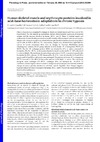Identificador persistente para citar o vincular este elemento:
https://accedacris.ulpgc.es/jspui/handle/10553/6571
| Título: | Human skeletal muscle and erythrocyte proteins involved in acid-base homeostasis: adaptations to chronic hypoxia | Autores/as: | Juel, C. Lundby, Carsten Sander, M. Calbet, J. A.L. van Hall, Gerrit |
Clasificación UNESCO: | 241106 Fisiología del ejercicio | Palabras clave: | Hypoxia Altitude Blood Erythrocytes Lactate |
Fecha de publicación: | 2003 | Publicación seriada: | Journal of Physiology | Resumen: | Chronic hypoxia is accompanied by changes in blood and skeletal muscle acid-base control. We hypothesized that the underlying mechanisms include altered protein expression of transport systems and the enzymes involved in lactate, HCO3- and H+ fluxes in skeletal muscle and erythrocytes. Immunoblotting was used to quantify densities of the transport systems and enzymes. Muscle and erythrocyte samples were obtained from eight Danish lowlanders at sea level and after 2 and 8 weeks at 4100 m (Bolivia). For comparison, samples were obtained from eight Bolivian natives. In muscle membranes there were no changes in fibre-type distribution, lactate dehydrogenase isoforms, Na+,K+-pump subunits or in the lactate-H+ co-transporters MCT1 and MCT4. The Na+-H+ exchanger protein NHE1 was elevated by 39 % in natives compared to lowlanders. The Na+-HCO3- co-transporter density in muscle was elevated by 47-69 % after 2 and 8 weeks at altitude. The membrane-bound carbonic anhydrase (CA) IV in muscle increased in the lowlanders by 39 %, whereas CA XIV decreased by 23-47 %. Levels of cytosolic CA II and III in muscle and CA I and II in erythrocytes were unchanged. The erythrocyte lactate-H+ co-transporter MCT1 increased by 230-405 % in lowlanders and was 324 % higher in natives. The erythrocyte inorganic anion exchanger (Cl--HCO3- exchanger AE1) was increased by 149-228 %. In conclusion, chronic hypoxia induces dramatic changes in erythrocyte proteins, but only moderate changes in muscle proteins involved in acid-base control. Together, these changes suggest a hypoxia-induced increase in the capacity for lactate, HCO3- and H+ fluxes from muscle to blood and from blood to erythrocytes. | URI: | https://accedacris.ulpgc.es/handle/10553/6571 | ISSN: | 0022-3751 | DOI: | 10.1113/jphysiol.2002.035899 | Fuente: | Journal of Physiology[ISSN 0022-3751],v. 548, p. 639-649 |
| Colección: | Artículos |
Vista completa
Citas SCOPUSTM
105
actualizado el 08-jun-2025
Citas de WEB OF SCIENCETM
Citations
93
actualizado el 08-jun-2025
Visitas
219
actualizado el 27-sep-2025
Descargas
343
actualizado el 27-sep-2025
Google ScholarTM
Verifica
Altmetric
Comparte
Exporta metadatos
Este elemento está sujeto a una licencia Licencia Creative Commons

